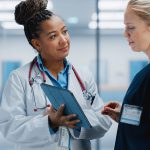Four examples of effective software for data sharing in the medical sector
“The duty to share information can be as important as the duty to protect patient confidentiality.” Dame Fiona Caldicott (Reference: Caldicott Review: Information Governance in the Health and Care System, 2013)
What do we mean by data sharing?
Most of us know what we mean by data sharing in general terms, but what does this mean when we are talking about the medical sector? What kind of data could and should be shared? This will naturally vary for each medical application.
As with every sector or industry, there are many different kinds of data used and recorded in healthcare. Different types of data are useful for different purposes and, importantly, can have different levels of sensitivity or confidentiality. A recent article published in Frontiers in Digital Health suggests a classification of 4 types of data:
- patient data
- health systems data
- public health data
- health research data
Why does data sharing matter?
Effective research data sharing can provide researchers and decision makers much needed information to guide policy and protocol.
The EUROCAT network, for example, is a network of registries for surveillance of congenital anomalies across Europe holding data going back to 1979. One aim is to facilitate the early identification of drugs and chemicals that cause congenital abnormalities (like thalidomide, for example).
EUROCAT supports improving healthcare and patient outcomes relating to congenital abnormalities. By sharing data effectively, medical personnel can save more lives and improve quality of life. However, data sharing must also be done with care as there are many considerations around cleanliness of data, data confidentiality and ethical approvals, to name a few.
Well designed software facilitates data sharing
BioMedical has worked on many medical data sharing projects and we have a lot of experience in designing successful software solutions.
When the software is doing its job, the researchers and medical professionals using it hardly realise it’s there. They use it and get on with the job of improving healthcare policy and procedures or treating patients.
So what are examples of data sharing projects we’ve worked on and what was important for the software development? Read on to find out.
EUROCAT project
(Development partner from 2000 – 2016)
As mentioned above, the EUROCAT network facilitates the collection and sharing of data relating to congenital abnormalities from countries across Europe. It holds data from 44 active member registries, each of which gathers data from different geographic regions. Biomedical developed and maintained the EDMP (Eurocat Data Management Program) until 2016 when it was replaced by DMS.
The EDMP software supported effective data sharing by:
- providing data collection and database management functions including data validation
- ensuring accurate and standardised data from across all registries
- reporting prevalence rates of congenital abnormalities
- managing statistical monitoring of clusters and time trends.
EUROlinkCAT
(Development partner from 2017 – 2022)
EUROlinkCAT was a Horizon 2020 funded project that established a dataset containing ten year survival, morbidity and educational data for a cohort of children with congenital anomalies utilising shared EUROCAT data as a starting point. The research described differences between survival rates, hospital admissions and health outcomes for children with and without congenital abnormalities. You can view infographics created using the data here.
BioMedical’s involvement included:
- creating a common data model as part of standardising the linked data
- developing the EUROlinkCAT website and data definitions
- developing web tables to display aggregated data to users (with distinctions between data available on public section of website and on member-access section.)
- programming on mortality and morbidity reporting
- Steering committee member to give expert advice.
Global Birth Defects App
(Development partner since 2018)
Aiming to support health workers in low and middle income countries, the Global Birth Defects App is designed to offer support for describing and coding externally visible birth defects.
BioMedical’s role was to develop the app using the content (images / text / videos of babies to demonstrate birth abnormalities) and user flow provided by the International Committee for Congenital Anomaly Surveillance Tools. Important considerations for app development included:
- can be used on mobile phones, tablets, Android and IOS operating systems
- intuitive user interface allowing users to navigate the app image content
- day to day operation of the app without internet connection
- multiple user accounts on the same device
- both low barriers to access and protection regarding ethical approval & security.
The last point above is an interesting one. The app needed to be easy for workers with varying medical and technical skills to access, yet also support the necessary ethical approvals and data security for any users uploading data on birth defects.
These two requirements would work against each other, meaning either one or both couldn’t be fully met in one app. As a result, we recommended developing two versions. The Basic version is quick and easy to register, whereas the Surveillance Version requires a unique registration code, issued by the governing body. Only the Surveillance Version allows uploads to a secure server from the user’s mobile device.
Read our case study on development of the Global Birth Defects App.
Institute of Cancer Research (ICR)
(Development partner since 2009)
The breast cancer research division at ICR aims to identify both genetic and environmental causes of breast cancer in order to improve diagnosis, discover new targets for cancer therapies and assess patient prognosis more accurately.
Follow up questionnaires with patients who are part of breast cancer studies is a crucial part of the research data gathering. Biomedical’s work with ICR was to develop software to move from paper follow-up questionnaires to online questionnaires.
The aim was to introduce better data cleansing and also speed up the collation and analysis of the data. The benefits included using ICR’s resources more effectively and moving to data analysis more quickly, leading to faster discovery of useful information for patients.
